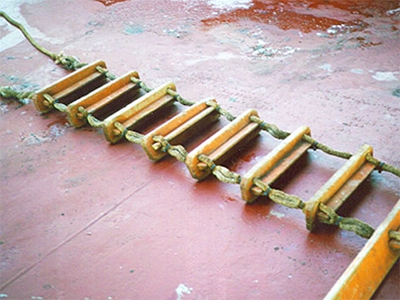The Ship-owners P&I Club has issued bulletin on the maintenance of pilot ladders to bring major concerns to the attention of the crew and ensure that pilot ladders and other associated pilot boarding arrangements are maintained to the highest standards at all times.Pilot ladders remain the most efficient way for pilots to board vessels and even though this is a simple process improper pilot boarding arrangements continue to give rise to claims.
These can include serious injuries to pilots occasionally resulting in death.Pilots are typically required to board ships at sea, sometimes with high freeboards in order to assist with the manoeuvring of the vessel.
Pilot boarding arrangements generally consist of a rope ladder which is constructed to the overseeing authorities’ statutory requirements. In case of excessive freeboards, combination ladders (a combination of the ship’s gangway and the pilot ladder) are used.
Defective ropes and/ or steps are one of the major causes of accidents associated with pilot ladders. Planned maintenance systems on board the vessels should include periodic inspection of the boarding arrangement systems, in particular the pilot ladder and should be an ongoing process. Each pilot ladder, accommodation ladder and its associated equipment should be properly maintained, stowed and inspected.
The importance of being stringent in these inspections cannot be emphasised enough as the pilot ladder remains by far the weakest link in the boarding arrangements. Failure to notice deterioration of the natural fibre ropes used in the pilot ladder construction or broken/torn chocks used to support the ladder steps/spreaders can cause the ladder to give way under stress. This can result in the pilot falling onto the pilot boat overside which can cause serious injuries or prove fatal.It is imperative that the pilot ladder certificates, periodic inspection reports and records are maintained on board and these detail the actual condition of the pilot ladders.
The verification of these records should be included in shore side internal audits.The Code of Safe Working Practices for Merchant Seamen – 2015 edition published by the UK Maritime and Coastguard Agency provides detailed guidance regarding pilot boarding arrangements.Pilot boarding arrangements, standards and requirements are stipulated by SOLAS Chapter V/Regulation 23. This regulation also requires that the pilot ladder must be certified by a manufacturer who meets the criteria set in regulation 23.
Various industry bodies such as the International Chamber of Shipping (ICS) have produced shipping industry guidance on pilot transfer arrangements in collaboration with the International Maritime Pilot’s Association (IMPA). These are aimed at reminding seafarers of the significance of adhering to these regulations and also the importance of establishing procedures to ensure safe boarding arrangements for pilots. View guidance from the ICS.
Source: The Shipowners P&I Club, Image Credit:TSB Canada


























































